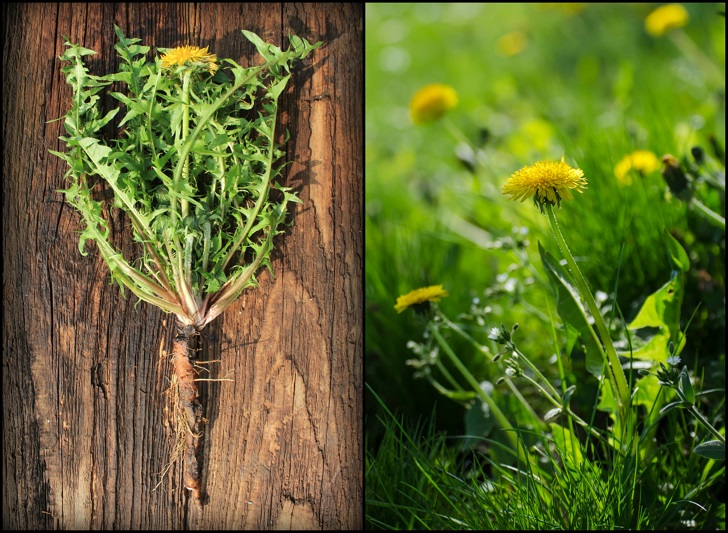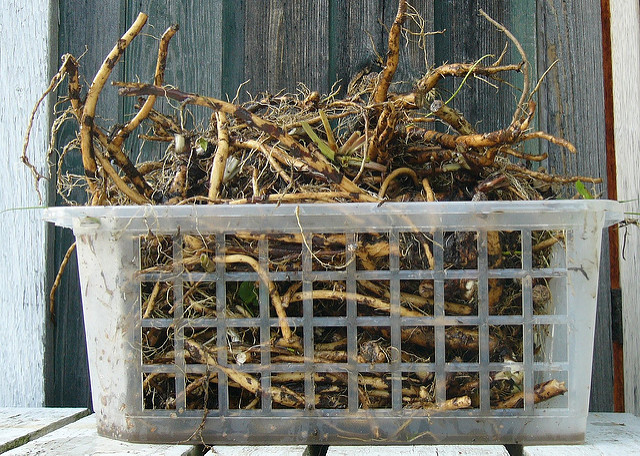
For centuries, dandelion has been embraced by herbalists and natural living enthusiasts to treat everything from liver problems to digestive issues.
Every part of this healing weed is edible – from the blossoms and leaves right down to the oft forgotten roots. However, it’s these deep roots that contain so many of the plant’s health benefits. Not only are they a rich source of vitamins A, B, C and D, as well as minerals such as iron, potassium and zinc; but the bitter substances in these tubers also aid in detoxification and liver stimulation.
Keep reading to discover how to harvest and use dandelion roots for better health and vitality.
Harvesting Dandelion Roots
For medicinal purposes, dandelion roots are best harvested in fall – particularly after a heavy rain, which serves to loosen the soil around the roots. Dandelion roots grow deep – up to one foot in length. It’s these tough, long roots that are responsible for the plant’s high levels of nutrients – the dandelion can reach deeper into the rich soil than other plants can for nourishment. This is also why they are a little difficult to harvest but, by following the below steps, you’ll soon be reaping the benefits of dandelion root.
Harvesting in fall also means that the levels of the insoluble fiber inulin will be higher, while fructose (sugar) levels will be lower. On the other hand, if you require the roots for culinary purposes, spring roots (before the plants blossom) are best. At this time of the year, they will contain less fiber and are less bitter and chewy. Spring roots are also higher in taraxacin, the substance in dandelions which stimulates bile production and aids liver function.
Because dandelion is a potent detoxifier, you should gather dandelion away from busy roads and other polluted areas, ensuring the plants haven’t been treated with chemicals.
Now that you know when and where to harvest dandelions, let’s look at how to do it.
- Choose the largest and most vigorous plants, leaving smaller dandelions alone. Not only do these have small roots but they are excellent food for bees, beetles and birds.
- Using a garden fork – or even better, a specialized dandelion root removing tool – gently work through the moist soil, being careful not to break or damage the root – the medicinal properties lie within the precious sap, housed inside these tough tubers.
- Once you have released the entire root from the ground, gently shake it to remove excess soil and scrub it thoroughly until clean. It’s now ready to use immediately or preserve.

Preserving Dandelion Roots
Dandelion roots can be used fresh from the ground for both culinary and medicinal purposes but if you want to store some of your harvest for future use, you’ll need to dehydrate it.
If you have a dehydrator, simply slice the cleaned roots into strips of equal size and dry them until brittle.
Alternatively, wrap each whole root with a long piece of string and hang in cool, dry location with good air flow for several days until completely brittle. Once dry, cut into small pieces.
Whichever method you choose, store your dried root in a glass jar for up to a year. If dried correctly, the outer flesh of the dandelion root should have a dark color while the inner flesh should be creamy white.
Using Your Dandelion Root
There are several ways to utilize your dandelion root harvest. Here are some of the best:
1. Dandelion Root Tincture
A tincture is a fast-acting, alcohol-based plant medicine. Dandelion root tincture is used for its anti-inflammatory properties. It is also said to be a fantastic diuretic, blood cleanser and natural detoxifier for the liver, spleen and gallbladder.
Herbalists use the dandelion root tincture to improve overall health and vitality, regulate blood sugar, reduce stress, eliminate age spots and clear up skin condition like psoriasis, eczema, and acne.
To make a tincture:
- Place the dandelion root in a jar and cover with 100 proof (50%) vodka. Ensure there is at least an inch of vodka above the dandelion roots. The 100 proof vodka enables the alcohol concentration to stay high enough to prevent fermentation and rot.
- Cover tightly and allow to steep for 6 weeks, shaking daily.
- Strain out the root using a muslin cloth and store the liquid tincture in a sterilized dark glass bottle. Compost the roots.
- For optimum health, take a few drops daily in juice or water.
2. Dandelion Root Infusion / Tea
Probably the most common use of dandelion roots, this healing tea is high in antioxidants, helps balance blood sugar, aids digestion, acts as a natural diuretic and mild laxative, cleanses the liver, prevents UTIs and more.
To make this simple infusion:
- Place one ounce of dried roots or two ounces of fresh roots in a pot with one pint of water. Bring to a boil, cover, and simmer for 20 minutes. Strain and compost the roots.
3. Dandelion Root Decoction
A decoction is an infusion which has been reduced to one-half its volume by slow evaporation. They are more potent than infusions and keep for longer if carefully stored under refrigeration.
You can use the decoction for anything you would use the infusion/tea – except you can simply imbibe a smaller amount for the same effect. This makes decoctions particularly effective for treating children or animals. One cup of infusion is equal to one quarter cup of a simple decoction.
To make a decoction:
- Make the simple infusion/tea outlined above.
- Heat the infused liquid until it begins to steam (but before it simmers). Turn the heat to low and steam until the liquid is reduced to one quarter of its original volume.
- Once cooled, pour the decoction into a sterile dark bottle and store in the refrigerator.
4. Dandelion Root Poultice
Dandelion root can be used in a poultice to treat skin disorders like acne, eczema, itching, psoriasis, rashes, abscesses and boils.
Follow the steps below to make a simple poultice:
- Process one cup of dried dandelion root in a food processor into a fine powder.
- Add a small amount of warm water to the powder to form a thick paste.
- Spread the paste over a piece of gauze and apply to the clean, dry, affected area.
- Wrap the poultice with plastic wrap and a towel and secure it with a safety pin.
- Leave for 20 minutes to three hours as needed and repeat as necessary.
5. Dandelion Root Coffee
Roasted dandelion root is a delicious caffeine-free alternative to coffee. Combine it with roasted chicory root for a deep, slightly bitter flavor. This recipe also mixes in cinnamon for a sweet spiciness with added healing properties.
To make:
- Place four cups of water, two tablespoons of ground roasted dandelion root, two tablespoons of ground roasted chicory root and one cinnamon stick in a pot.
- Bring to a boil, then simmer for five minutes.
- Strain and enjoy your healthy coffee substitute, adding a milk of your choice if desired.
6. Dandelion Root Vinegar
Blend dandelion root with apple cider vinegar for a delicious vinegar that works well in salads and soups. You can also add it to water to get your daily dose of apple cider vinegar with the extra health benefits of dandelion.
For a gut friendly vinegar simply:
- Fill a mason jar two-thirds full with finely chopped fresh or dried dandelion root. Fill to the top with raw apple cider vinegar with ‘the mother’.
- Leave to infuse for six weeks, in a cool place away from direct sunlight, before straining through a muslin cloth. Store in a sealed glass jar.
7. Dandelion Root Smoothies
If you’re a green smoothie lover – and here are 13 reasons why you should be – consider adding some dandelion root to your shake to boost the nutritional content and support the liver.
If using dried root, place it in the blender and process to a fine powder before adding the other ingredients. If using fresh dandelion root, you can blend it with all the other ingredients as normal.
Precautions
Dandelion is generally considered safe to take, although medicinal herbs are potent time-honored treatments so speaking to your doctor before use is recommended.
Avoid dandelion if:
- You are allergic to ragweed, chrysanthemums, marigold, chamomile, yarrow, daisies, asters or iodine.
- It triggers heartburn symptoms or irritates the skin.
- You are pregnant or nursing.
Those who have gallstones, biliary tract obstruction, stomach ulcers, gastritis or irritable bowel should speak with their health care provider before taking dandelion, as should those on potassium supplements, blood thinners or medications to treat infection.
Wondering what to do with your leftover dandelion leaves and blossoms? Here are 25 great ideas for you to try out.
